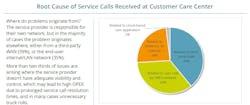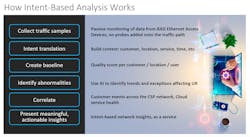Harnessing Network Data for Customer Experience Insights
The future of networks lies in the ability to gain instant intent-based insights that drive actionable intelligence, and we’re living in exciting times as this possibility is emerging. Raw network data, previously used only for internal technical purposes, can be harnessed for efficiency, credibility, and revenue, with benefits for CSP operations and customers alike. Networking tech-speak now speaks to any user.
To provide context for intent-based insight use cases, let’s first look at the challenges facing CSPs today. To begin with, it’s clear that bandwidth requirements have skyrocketed over the past two years, as “Work from Anywhere” is the new norm, and videoconferencing remains prevalent despite the recent return to the office.
According to a recent global survey1 of 100 CSP executives about business connectivity trends, we know the following: a) 1-Gbit connectivity no longer meets business needs—100G L2 business services are now required in most markets. b) Quality of service matters far more to CSPs than traditional differentiators, such as price point.
Over the past several years, enterprise customers have migrated their workloads from private data centers to public clouds. Many business customers prefer L2 VPNs and premium direct Internet access services as these can ensure high quality, service-assured connections between enterprise branches to the public cloud. This cloud migration is one driver for the higher bandwidth requirements of L2 business services, yet also poses a challenge for CSPs and end customers alike. When mail servers, storage servers and video applications are moved from the private enterprise data center to the public cloud, enterprises have lower visibility and control of network performance, which in turn negatively affects the quality of user experience.
"For the sake of cost savings and ease of deployment, such capabilities shouldn’t require the installation of yet additional probes in the network but rather use a SaaS model that collects the data from Ethernet access devices (EADs/NIDs) already installed at the edge of the network as the customer-network demarcation for direct Internet access and VPN services."
From their end, CSPs also see only part of the picture. This is because up to now they could not attain any insights about networking issues in the enterprise branch segment or in the public cloud.
To succeed, carriers must gain greater visibility and control over their customer experience. Meeting the SLA commitment to the customer is critical, of course, but in many cases SLA commitment alone is not enough. Enterprise operations are dependent on high network availability, yet the CSPs SLA metrics aren’t aligned with business customer goals. Focusing on organizational productivity, enterprise customers don’t care—nor should they—about common service provider operational metrics such as delay variation, packet loss and other CSPs network KPIs. Instead, SLAs should include terminology that is clear to business professionals and corresponds with the way they use connectivity services. It should also cover the entire service path, end to end, from a branch location through the CSPs network and all the way to the application running as a workload in the public cloud.
Given the centrality of quality of experience (QoE) for customer retention and attraction, intent-based insights as a service are a new effective means for the CSPs success.
Ensuring Network Integrity: Actionable Insights for Fault Isolation
A prime example where intent-based insights are useful for CSPs SLA is network fault isolation monitoring. According to the survey cited earlier, the root causes of 76% of service outage complaints are not in the CSPs domain. Instead, the problem usually lies in the cloud application or even the customer’s own LAN. This means CSPs waste OpEx on call center resources, tech support, and truck rolls to troubleshoot problems that are not theirs. (See Figure 1.)
The Alternative View
What if call center personnel and operations staff could immediately see the source of service issues, even if it is outside of the CSPs network? What if an alarm is raised when the service begins to degrade, even before the customer feels it? What if the customer could use a self-service portal that tells them the quality score of the service they’re purchasing, in a language that makes sense to them rather than in networking-techspeak?
Needless to say, such visibility should extend end-to-end, from the customer’s own LAN through the service provider network and all the way to the cloud application.
To allow such visibility, CSPs need to monitor performance and user experience over the entire service path. For the sake of cost savings and ease of deployment, such capabilities shouldn’t require the installation of yet additional probes in the network but rather use a SaaS model that collects the data from Ethernet access devices (EADs/NIDs) already installed at the edge of the network as the customer-network demarcation for direct Internet access and VPN services.
Such a tool would correlate the collected data with information from additional sources (such as public cloud application health) and create a baseline for user experience against which performance is measured to identify anomalies or degradation. The display should use layperson terms such as customer names, locations, service type, and usage application/destinations in public clouds. Users, therefore, can be anyone—from technician to call center staff to end user.
Ideally, such a performance monitoring tool applies intent-based AI to pinpoint whether network degradation is due to customer LAN or cloud-based applications, not only the CSPs WAN. Within seconds, users can quickly identify the source of malfunctions or service degradation and determine whether their connection problems stem from the provider or from a non-CSPs network domain segment.
The name of the game is to leverage existing data and transform it into customer-centric terminology with meaningful and actionable insights. This is done for service segments within and outside of a CSPs network domain, allowing their staff to quickly address customer complaints while avoiding service-affecting procedures, as well as expensive and lengthy troubleshooting sessions.
By identifying the root cause efficiently, solution paths can be devised faster, thereby reducing cost and strengthening customer relations. These intent-based insights-as-a-service lead to an increased business customer base on the macro level by bolstering a reputation of reliability, and on the micro level as an add-on for end customers. All this is possible by using pre-existing data for customer benefit of faster, lower cost, non-traffic-affecting troubleshooting.
The Insider View
The ability to instantly access data in a relatable way benefits CSPs in several ways, from streamlining their workflows and giving real-time inputs to their customers to offering targeted value-added services.
End-to-end network performance monitoring that considers the context of the end customer application gives CSPs visibility into how their customers are using their network across the entire traffic path. (See Figure 2.)
This type of performance monitoring can analyze usage over time to identify trends and abnormalities and assign quality scores per customer, location, and service. This must be accompanied by a cloud-hosted, AI-powered portal that exhibits the insights on a single pane of glass. For CSPs, it is a leap forward from the days of on-site, complex and time-consuming fault isolation and troubleshooting processes that negatively affect service. As CSPs support and operations teams immediately identify the network segment responsible for the problem, they empower their business end customers to view the insights themselves, preventing unnecessary service calls.
"Focusing on organizational productivity, enterprise customers don’t care—nor should they—about common service provider operational metrics such as delay variation, packet loss and other CSP network KPIs. Instead, SLAs should include terminology that is clear to business professionals and corresponds with the way they use connectivity services."
Intention Matters
Harnessing data from existing Ethernet access devices and applying AI algorithms to gain insights means going beyond a network-centric scope to incur OpEx savings on troubleshooting and build context that corresponds with customer intent. As part of this customer-centric refocus, terminology reflects the language of the user’s purview, providing instant access to the customer user experience that is immediately relatable. Using intent-based insights, CSPs enhance enterprise and end-customer satisfaction.
Looking ahead, future intent-based insights can be used to identify various package upgrade offerings by monitoring customer and service trends and proactively identifying traffic upswings, user experience deviations and alerts.
REFERENCES AND NOTES
1. https://www.rad.com/resources/white-papers/csp-survey-l2-business-services-and-5g-xhaul?utm_source=ISEmag&utm_medium=article&utm_campaign=DK_May2022_RADinsight
ABOUT THE AUTHOR
Ilan Tevet, VP of Marketing and Business Development, RAD, has 20 years of experience managing the life cycle of networking, SDN/NFV, vCPE, industrial IoT, and cybersecurity solutions. For more information, email [email protected] or visit: https://www.rad.com/products/radinsight-pm?utm_source=ISE&utm_medium=article&utm_campaign=DK_2022_TheFullView Follow Ilan on Twitter @Ilan_T. Follow RAD on Twitter @RADdatacomms, LinkedIn: rad-data-communications and Facebook: RAD.Data.Communications.







